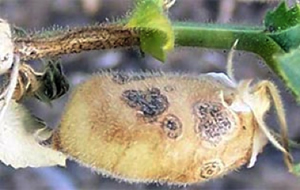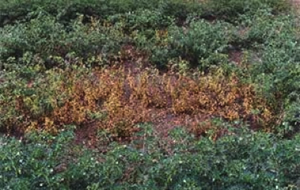Ascochyta blight of chickpea
Ascochyta blight of chickpea is caused by the fungal pathogen Ascochyta rabiei (formerly known as Phoma rabiei). Variety selection, along with an understanding of the associated disease management package for the variety being grown, is critical for success.
What to look for
This disease is usually first noticed in late winter when small patches of blighted plants appear throughout the paddock.
These spots rapidly enlarge under cool and wet conditions, joining with other spots on the leaves and blighting the leaves and buds. Small black spots (pycnidia), less than 1mm in diameter, can be seen in the affected areas (Figure 1).
In severe cases of infection the entire plant dries up suddenly and small patches of brown, dead plants appear throughout the paddock.

The disease spreads during cool, wet weather from infected plants to surrounding plants by rain splash of spores. This creates large blighted patches within crops (Figure 2).
As the disease progresses elongated lesions can often form on the stem and lead to stem girdling and the stem may die and break off.
The fungus can penetrate the pod and infect the seed. Severe pod infection usually results in reduced seed set and infected seed. When infected seeds are sown, the emerging seedlings will develop dark brown lesions at the base of the stem. Affected seedlings may collapse and die.
Disease cycle
This fungal disease has an asexual and sexual stage; the asexual stage is most common in Australia. In this stage the fungus survives mainly on infected seed and on crop residues.
Spores of the fungus produced on crop residues are carried into new crops by wind. Infection can occur at any stage of plant growth, provided conditions are favourable.
Moisture is essential for infection to occur. During wet weather, the disease can spread further than in dry conditions because spores of the fungus are carried onto neighbouring plants by wind and rain splash.
Ascochyta can develop over a wide range of temperatures (5–30°C) but develops fastest when temperatures are between 15 and 25°C and relative humidity is high. Symptoms become visible in 4–5 days and pycnidia develop in 7–10 days.
Multiple cycles of infection can occur during the growing season.
Economic importance
To successfully grow varieties where the ascochyta disease rating is less than moderately resistant, foliar fungicides need to be applied throughout the growing season to avoid serious yield losses.
When selecting varieties the added cost of fungicide applications needs to be considered before selecting and growing susceptible to moderately susceptible varieties.
Management
Management requires a combination of farm hygiene, resistant varieties, crop monitoring and the use of fungicides. When growing a new variety, obtain a copy of the variety management package for information on specific disease management.
Variety
Select the variety with the highest level of resistance for ascochyta blight in your district. There are a range of ascochyta disease ratings available in the commercially available varieties.
For further information on disease ratings refer to the Victorian Pulse Disease Guide.
Seed selection
Use seed from a paddock where ascochyta was not detected or was well managed. A key strategy is to consider growing varieties with the highest resistance ratings available, however all varieties will require at least one fungicide application at early podding to prevent seed infection.
Seed treatment
Treat all seed with a seed dressing registered for ascochyta blight control.
Paddock selection
Choose a paddock at least 500m from last year's chickpea crop.
Sowing rate
Follow the recommended sowing rates for your district. Remember that sowing rates may vary between varieties.
Time of sowing
Early sowing encourages early infection and increased levels of the disease. Follow the recommended sowing dates for your district.
Foliar fungicides
The fungicide application regime required will depend on several factors including the variety grown, in-season rainfall and the disease risk.
Resistant varieties will not require spraying for ascochyta blight prior to podding. A single application of fungicide at podding should be sufficient to prevent seed infection for these varieties.
Susceptible varieties will need fungicide applications throughout the growing season, as well as podding (to prevent pod infection).
Note that fungicide sprays are best applied prior to a rain event.
Harvest
Plan to harvest as early as possible to minimise disease on seed.
All current resistant varieties still require spraying at podding as the pods are susceptible to infection.
Further information
Detailed information on each of the pulse diseases can be obtained from:
- Seed Health Testing in Pulse Crops
- Pulse Australia
- National Variety Trials
- Chickpea Southern Region – GrowNotes
- Victorian Winter Crop Summary
- Victorian Pulse Disease Guide
- Pulse Seed Treatments and Foliar Fungicides
Contact
Pulse Pathologist - Horsham
Dr Joshua Fanning
0419 272 075
Field Crops Pathology
Grains Innovation Park
110 Natimuk Rd
Horsham 3400
03 5450 8301
Or call the Customer Service Centre, 136 186
Acknowledgements
Trevor Bretag, Helen Richardson, Luise Sigel, Agriculture Victoria, Horsham. Support by Grains Research and Development Corporation is gratefully acknowledged.